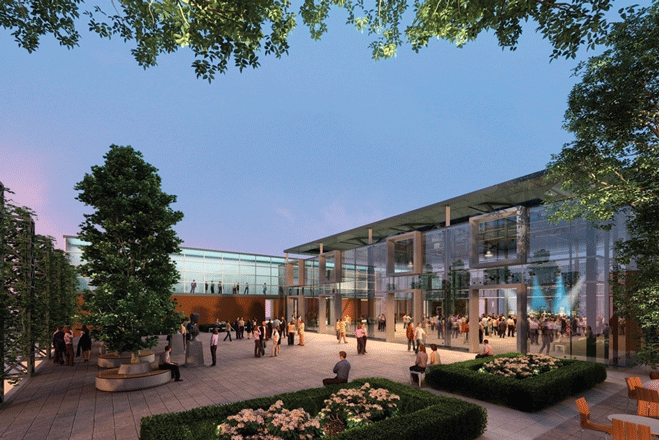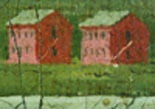“Place is absolutely important in our history. Time and place are interconnected and we must have a sense of roots in a city so diverse. The collective memory is anchored and connected in place. This site was a game changer in the civic life of Canada and it is long overdue that we have civic access to it.” DAVID CROMBIE Toronto Mayor 1972-78
By Frank Touby –

Proposed Founders’ Courtyard, looking toward library, left, with community space at right.
The return to the public of the site of Upper Canada’s First Parliament Buildings, 1798, is now under active pursuit—even hyperactive pursuit. Detailed plans for a stunning interpretation centre, park, library and pilgrimage centre that have been praised by a wide array of citizen, business, political and history groups are being made public for the first time.

Canada’s First Parliament Buildings
Whether this can become reality for residents and tourists depends upon how we respond to central questions about our history.
Is there such a thing as hallowed ground? Should we really care whether we can be on the actual place where monumental historic events occurred that were crucial in creating our present time? Or is a carwash or a condo on the site just fine, so long as there’s perhaps a patch of commemorative ground or a plaque?
One of the most significant sites in all of Ontario is in the St. Lawrence Neighbourhood of Old Town Toronto. It’s the site of Upper Canada’s (Ontario) First Parliament buildings, burned to the ground in the War of 1812 and situated on the southwest corner of Front and Parliament streets.
The place just brims with important aspects of our history, likely more so than any other patch of ground in Ontario, and certainly more than any other industrial property in the province. If there are ghosts, they are surely on this site of distinction, of glory, and of untold misery and suffering.
Parts of it remain in private hands, though most have been acquired for heritage interpretation. Yet there’s still the off chance that a condo or some other use could end up where the car wash is.
Certain warehouse-types of buildings (car dealers, the Staples store) are often used by landowners to get revenue while storing land that’s expected to jump in price. Downtown the highest price for land is if a high-density condo can be built on it.
The Porsche site is now in provincial hands and the dealership is relocated across the street on the northwest corner.
An offer of a land swap has been made to the owners of the carwash, but the deal has lagged too long, according to Rollo Myers of Citizens for the Old Town historical preservation society. It’s been 15 years in the works, Myers says. He’s also manager of the Toronto office of the Architectural Conservancy of Canada.
The urgency comes from plans underway to commemorate the War of 1812 in Old Town Toronto with the First Parliament site playing a key role. The First Parliament buildings were burned down by the Americans in 1813 during that war which the U.S. lost and which ended in 1814.
There is time to construct some version of the hoped-for park-interpretation centre and library facility by 2013. An option discussed is to relocate the warehouse-like Toronto Library distribution-centre building across Parliament on the east side onto the site which would include the planned West Don Lands library that was intended for across Parliament.
That was phased into the plan created with lots of stakeholder input by local resident and architect J. Michael Kirkland, who recommended the library inclusion.
The proposal, which has been seen by hundreds and is shown here in part for the first time, includes an indoor-outdoor community space that opens onto a landscaped courtyard when the weather permits.
An architectural dig on the site in 2000 showed foundations and evidence of burnt floor boards dating to the American attack in 1813, says Myers. The site has artifacts from pre-European days, to parliamentary, to penal, to industrial in the form of Consumer’s Gas early times
The dig also uncovered the horrors of an early jail, the York County Jail, precursor to the Don Jail. The jawbones of oxen found there told the unappetizing story.
In Myers’ words: “Completed in 1842, this muscular limestone jail was the last word in penitentiary design, and said to be a modified version of the UK’s Jeremy Bentham’s ‘panopticon’ (“to observe all prisoners”) dating to the 1780s and ‘A new mode of altering power of mind over mind in a quantity hitherto without example.’
“The radiating wings reduced staffing since the cells could be supervised from the central tower. Clearly built to last for a century or more, it was phased out after just 16 years and replaced by the Don Jail. The panopticon had come to be known more for prisoner isolation than prisoner surveillance.
“Perhaps a more enlightened age of prison reform caused its premature closing. Yet even the Don Jail gained a reputation for breaking a man’s spirit, and one is left to wonder what dire conditions existed here.
“One clue is that during the archaeological test dig at the site in 2000, a great number of bone fragments were found and determined to be from the jaw bones of oxen. Seems that if as a prisoner you didn’t have someone to help secure better rations, jaw-bone soup— the least appetizing meal—was all that was provided.
We learn from the past, or we are bound to repeat those errors. Many citizens of Downtown Toronto are convinced that a combined teaching, tourism, recreation and community centre on this rich historic site, incorporating most or all of the plan they’ve seen, is the best use of the land and that it must be totally in public hands.
Construction in time to commemorate the bicentennial of the Americans burning down Upper Canada’s First Parliament buildings in 1813 is a timely target to aim for in their opinions.
 TheBulletin.ca Journal of Downtown Toronto
TheBulletin.ca Journal of Downtown Toronto

